For months now, New Yorkers have been bent out of shape, either cooped up at home or stretched thin on the front line of what’s happening during the COVID-19 pandemic. It’s strange to think of the world we all inhabited a few months ago, the casual freedoms we enjoyed: seeing friends, going out to eat.
In his ambitious illustrated history The Dairy Restaurant, Ben Katchor writes of “the mythology of an inaccessible or lost paradise: similar to a defunct eating place that one can know only from memory, or postcard images, but can never visit again.”
Mostly gone, largely forgotten, one-time New York institutions like Ratner’s and Rapoport’s hold a special place in Katchor’s heart. He recalls how, as a young man, “the appearance and atmosphere of these dairy restaurants… attracted me. I assumed that the resigned and forlorn air that filled these places was due to their being businesses in their final decline. Their customers had died or moved away, the cuisine they offered was no longer considered healthy or fashionable, and the owners did not want or expect their children to continue in their line of work.” Famous Dairy Restaurant (formerly on 72nd Street) is remembered for how a “long-suffering elderly waitress limped back and forth to the kitchen, a tiny saucer of creamed spinach in her trembling hand.”
The “modern American dairy lunchroom with its emphasis on cleanliness and efficiency” – tiled walls, small tables, a marble or enamel bar with stools – could at one time be found throughout Lower Manhattan, as well as in Brooklyn, upstate New York, Philadelphia, Baltimore, Miami, Chicago, Los Angeles, and even San Juan. Sharing reproductions of matchbooks and menus, Katchor laments that it’s “the twentieth-century Jewish dairy restaurant, possibly due to its utilitarian design and lack of picturesque ethnic qualities, that’s least memorialized and preserved.”

Katchor remembers sitting on a stool in front of a plate of gefilte fish at B&H Dairy on Second Avenue, and how a young woman plopped down next to him to ask what he was eating – a coy move to start a conversation. Later, he married her.
This personal history, while just one aspect of The Dairy Restaurant, is the most straightforward and moving. Katchor would have done well to build the structure of the book around his reminisces. Instead, he relegates them to the end, focusing, for the most part, on an unwieldy history of Jews (as recorded in the Bible) with a special interest in what was eaten, and where. He follows the evolution of the Jewish people and their migration to the New World and the New York restaurants they created, where “the Eastern European dairy dishes they grew up eating at home constituted a cuisine of their own and could serve as the basis for a specialty restaurant.”
Katchor begins dramatically, immediately, without introduction. A line from Genesis (1:2) is printed directly on the inside cover: “And the earth was without form, and void; and darkness was upon the face of the deep.”
The accompanying black and white drawing depicts a restaurant: an advertisement for borscht on the wall (75 cents a bowl), a bare light bulb, and a water level almost to the ceiling. Floating on top are bubbles and what look like bars of soap, labeled “carbon dioxide,” “carbon monoxide,” “methane.”
Soon after, Katchor takes us to the Garden of Eden (“the first private eating place open to the public”) where “the relationship between patron, proprietor, and waiter is established.” Katchor sees the creature tempting Eve as “a middleman in the business of human nourishment” and Adam and Eve’s move to cover themselves, after partaking of the forbidden fruit, as “the first account of dressing for dinner.”
Frequently digressing in his writing, Katchor also has a habit of illustrating not just what’s on the page, but what else is on his mind. For example: Abraham’s desert tent is imagined as the striped awning over a city storefront. The lively drawings, executed in black and white with sketchy lines and smears of shading, are mostly of squat-looking people (about three heads high). Although there’s a drawing on pretty much every page, this is a text-heavy history, nearly five hundred pages, dense and often going in many different directions at once.
Katchor writes of working on this project over many years, calling attention to the “interesting tidbits of information” and “collected discoveries,” warning that “the complete history of the dairy restaurant remains to be written.”
And Katchor’s book is a long sort of ramble, with only a little help from section headers here and there, ranging from the specific “Seventeenth-Century Vegetarian Resistance” to the general “Travel and Food.” Readers will be glad for these breaks.
Diving back in, Katchor parses out the “long and complicated history of cultural antagonisms, economic power struggles, and theological differences between the numerous Jewish sects” to determine the origins of the Torah’s commands “not to cook meat in milk, not to eat a combination of milk and meat, and not to profit from the cooking of meat in milk,” discovering how “ritual prohibition” becomes “dietary law” and then “culinary style.” Katchor writes, “According to Hasidic lore only kugel, or noodle pudding, is an authentic Jewish dish – all others are preexisting dishes adapted by Jews according to the possibilities of their dietary law.”
Katchor tracks down a few surviving owners of some of Manhattan’s dairy restaurants, including Pola and Salek Gefen of Gefen’s Dairy Restaurant, formerly on Seventh Avenue. New to the business, Pola easily adapted to cooking for a crowd, having been “used to cooking for at least eight people in Berlin – concentration camp survivors who had lost their families.”
Katchor writes, “Six million people with a taste for the Eastern European dairy dishes mentioned in this book were murdered in Europe in World War II. The remaining Jews and their children had a complex relationship to this cuisine. It may have been the beloved food of their childhood but it was often associated with the embarrassments of immigrant life, suffocating family relations, economic failure, or making them fat.”
“To some [the food of their childhood] is part of a lost paradise that they strive to return to for the rest of their life. To others, it represents a family bondage and provincialism, the escape from which they mark as a day of liberation.” Katchor seems like a little bit of both: someone who has cultivated a sophisticated palate, but is brought to his knees by a certain taste of home because of the flood of memories it invokes. “In the quiet of this restaurant with its faint smell of frying butter and sweet baked goods, I was truly in a walled paradise of sorts,” he writes of a restaurant of his youth. He’s a little bit like Proust with his madeleine.
One of the last images shows a man and woman standing in front of a gas station in yoga poses, in water up to their ankles. As if foreseeing the future (the book was published in March), the people wear masks on their faces. Giant hornets fly overhead.
Harder than remembering the world we left behind when we were quarantined is imagining the one we’ll make for ourselves when we emerge, pale and blinking, at some future point still to be determined. No doubt the first thing we’ll want to do is go get something to eat. Katchor’s book is a reminder that while our memories can sustain us for a lifetime, the places that nourish us are fleeting. If there’s a restaurant dear to you, make it a point to go there first.









